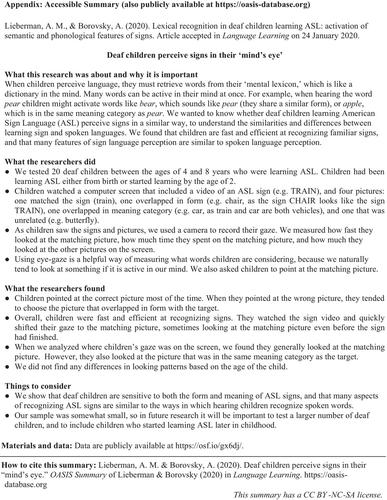当前位置:
X-MOL 学术
›
Lang. Learn.
›
论文详情
Our official English website, www.x-mol.net, welcomes your
feedback! (Note: you will need to create a separate account there.)
Lexical Recognition in Deaf Children Learning American Sign Language: Activation of Semantic and Phonological Features of Signs
Language Learning ( IF 3.5 ) Pub Date : 2020-06-03 , DOI: 10.1111/lang.12409 Amy M Lieberman 1 , Arielle Borovsky 2
Language Learning ( IF 3.5 ) Pub Date : 2020-06-03 , DOI: 10.1111/lang.12409 Amy M Lieberman 1 , Arielle Borovsky 2
Affiliation

|
Children learning language efficiently process single words and activate semantic, phonological, and other features of words during recognition. We investigated lexical recognition in deaf children acquiring American Sign Language (ASL) to determine how perceiving language in the visual–spatial modality affects lexical recognition. Twenty native or early‐exposed signing deaf children (ages 4 to 8 years) participated in a visual world eye‐tracking study. Participants were presented with a single ASL sign, target picture, and three competitor pictures that varied in their phonological and semantic relationship to the target. Participants shifted gaze to the target picture shortly after sign offset. Participants showed robust evidence for activation of semantic but not phonological features of signs. However, in their behavioral responses, participants were most susceptible to phonological competitors. Results demonstrated that single word recognition in ASL is largely parallel to spoken language recognition among children who are developing a mature lexicon.
中文翻译:

聋童学习美国手语的词汇识别:激活符号的语义和语音特征
儿童学习语言可以有效地处理单个单词,并在识别过程中激活单词的语义、语音和其他特征。我们调查了聋儿习得美国手语 (ASL) 的词汇识别,以确定视觉空间模式中的感知语言如何影响词汇识别。20 名本土或早期暴露的手语聋儿童(4 至 8 岁)参加了一项视觉世界眼动追踪研究。向参与者展示了一个单一的 ASL 标志、目标图片和三个竞争者图片,它们与目标的语音和语义关系各不相同。参与者在符号偏移后不久将目光转向目标图片。参与者展示了激活符号的语义特征而非语音特征的有力证据。然而,在他们的行为反应中,参与者最容易受到语音竞争者的影响。结果表明,ASL 中的单个单词识别与正在发展成熟词典的儿童的口语识别基本平行。
更新日期:2020-06-03
中文翻译:

聋童学习美国手语的词汇识别:激活符号的语义和语音特征
儿童学习语言可以有效地处理单个单词,并在识别过程中激活单词的语义、语音和其他特征。我们调查了聋儿习得美国手语 (ASL) 的词汇识别,以确定视觉空间模式中的感知语言如何影响词汇识别。20 名本土或早期暴露的手语聋儿童(4 至 8 岁)参加了一项视觉世界眼动追踪研究。向参与者展示了一个单一的 ASL 标志、目标图片和三个竞争者图片,它们与目标的语音和语义关系各不相同。参与者在符号偏移后不久将目光转向目标图片。参与者展示了激活符号的语义特征而非语音特征的有力证据。然而,在他们的行为反应中,参与者最容易受到语音竞争者的影响。结果表明,ASL 中的单个单词识别与正在发展成熟词典的儿童的口语识别基本平行。









































 京公网安备 11010802027423号
京公网安备 11010802027423号